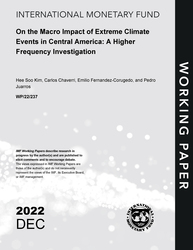
On the Macro Impact of Extreme Climate Events in Central America: A Higher Frequency Investigation
On the Macro Impact of Extreme Climate Events in Central America: A Higher Frequency Investigation
READ MORE...
Volume/Issue:
Volume 2022
Issue 237
Publication date: December 2022
ISBN: 9798400226021
$20.00
Add to Cart by clicking price of the language and format you'd like to purchase
Available Languages and Formats
| English |
Prices in red indicate formats that are not yet available but are forthcoming.
Topics covered in this book
This title contains information about the following subjects.
Click on a subject if you would like to see other titles with the same subjects.
Exports and Imports , Economics- Macroeconomics , Economics / General , Environmental Economics , Natural Disasters , Climatic disasters , high frequency , CAPDR , VAR , climate event , macro impact , panel VAR , frequency investigation , climate index , Natural disasters , Remittances , Climate change , Vector autoregression , Central America
Summary
Central America is one of the world’s most vulnerable regions to extreme climate events. The literature estimates the macroeconomic effects of climate events mainly using annual data, which might underestimate the true effects as these extreme events tend to be short-lived and generate government and family support in response. To overcome this limitation, this paper studies Central American countries’ macroeconomic impact of climatic disasters using high-frequency (monthly) data over the period 2000-2019. We identify extreme climate events by defining dummy variables related to storm and flood events reported in the EM-DAT (Emergency Events Database) and estimate country-specific VAR and panel VAR. The results suggest that a climatic disaster drops monthly economic activity in most countries in the region of around 0.5 to 1 percentage points on impact, with persistent effects on the level of GDP. We show that even as extreme climate events were relatively less severe under our sample period, quantitative effects are similar or larger than previously estimated for the region. In addition, remittances (transfers from family living abroad) increase for most countries in response to a extreme climate event, acting as a shock absorber. The results are robust to controlling for the severity of the climate events, for which we construct a monthly climate index measuring severity of weather indicators by following the spirit of the Actuaries Climate Index (ACI).
Copyright © 2010 - 2025
Powered by:
AIDC



